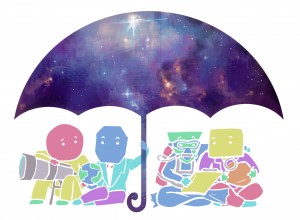Don’t let the lowercase ‘i’ throw you off – UCLA’s iPLEX isn’t the university’s way of adopting the Apple philosophy. iPLEX stands for Institute for Planets and Exoplanets, and seeks to promote interdepartmental collaboration and discussion of planetary science through weekly meetings, annual workshops and community outreach. After all, as various professors, researchers, graduate students and undergraduates have come to realize after attending iPLEX meetings, planetary science is more interdisciplinary than one might think. Listen to find out more on what the average iPLEX gathering is like, iPLEX research collaborations with NASA’s Jet Propulsion Laboratory and opportunities for space-interested students to get involved.

—————————–
TRANSCRIPT:
Broszus: Imagine that it’s one of those rare, rainy days at UCLA. Now picture a really, really large umbrella. Underneath that umbrella stands 30 or 40 professors, postdocs, grad students and undergrads from various physical science departments. They’re eating pizza and talking about space. That, essentially, is iPLEX. Geology Ph.D. student Ivy Curren and astronomy professor David Jewitt, the director’s assistant and director, respectively, of iPLEX, elaborate.
Curren: iPLEX is the Institute for Planets and Exoplanets. We’re kind of this umbrella organization. We don’t have a membership; if you’re doing planetary science you’re part of the club. And what we try to do is keep our eyes and ears peeled for really cool science that’s going on and promote that through various venues.
Jewitt: Basically it’s an institute whose purpose is to bring together people who study planets no matter what. No matter where the planets are, no matter what kind of planet they are.
Broszus: iPLEX is officially located in the department of earth, planetary and space sciences, but it also includes the department of physics and astronomy as well as the department of atmospheric and oceanic sciences. The real goal of iPLEX is to tear down the walls between people in various departments – or even people in the same department – in order to increase communication and collaboration between them concerning space topics and research. Planetary science is, after all, much more broad and interdisciplinary than we may think.
Jewitt: The physical separation between the buildings is, what, a couple hundred yards or something like that? But psychologically it’s a huge space.
Broszus: iPLEX aims to increase collaboration, discussion and dissemination of planetary science in a few ways. About once a year, it hosts a workshop where important scientists around the world come to give talks about a particular subject relating to current events in space. This school year’s conference, titled “The Asteroid-Meteorite Connection,” will take place in the spring and will focus on where various meteorites, asteroids and comets come from in the solar system, a highly debated issue in the space community.
Milewski: We want to foster any kind of collaborations, any kind of projects that we can work on within these interdisciplinary communities.
Broszus: That was Dave Milewski, a graduate student in the earth, planetary and space sciences department. As its social media manager, Milewski manages iPLEX’s social media on Twitter, Instagram and Tumblr – all at uclaiplex. In addition to spreading information about planetary science through online platforms, the directors hope to reach a wider audience through community outreach opportunities.
Curren: People want to see science, and that’s what we’re trying to provide them. It’s really fun to see someone’s eyes light up when they understand a concept for the first time.
Broszus: Sometimes, classes from schools in the L.A. area come to UCLA to tour the meteorite gallery, view the dinosaur fossils and practice experiments in the physical science departments. Most of the outreach requests come from schools in the L.A. area, but iPLEX isn’t only targeting a younger audience.
Curren: K to Gray, that’s what we say.
Milewski: Let’s say from ages 8 to 80, or even younger than that or older than that. Anyone who has a fascination with space, we want to recapture that fascination with space that they have.
Broszus: The limiting factor with iPLEX outreach is finding the manpower to run these events … and funding, of course. iPLEX is primarily funded by a half-million dollar grant from UCLA, but that money will eventually run out.
Jewitt: Money is the problem with being a scientist, frankly. That’s the horrible part of my job, is always, money. Cause the forces of darkness always try to turn scientists into basically businessmen, or businesspeople. Fundraising businesspeople.
Broszus: The crown jewel of iPLEX is its weekly meetings on Friday afternoons, which are more of an intimate affair than the annual workshops. An iPLEX member or guest speaker from an outside research institution like Caltech or the NASA Jet Propulsion Laboratory, gives an informal talk on a current event or topic in planetary science. It’s what you call a “pizza-assisted seminar” – new initiates might come for the pizza but stay for the science. And it works.
Milewski: If there’s ever an end-of-the world scenario and you want to bring in all the best scientists together, it’s like being in a DEFCON-5 meeting when they’re about to launch the nukes.
Jewitt: That’s the whole deal. We get these people with different backgrounds into a room so they have some possibility to communicate.
Broszus: Some previous topics have included updates on Io, a moon of Jupiter, the New Horizons mission for Pluto, the 30 meter telescope–the largest telescope in the world, and the number of Earth-sized exoplanets that have been discovered. Pretty much any topic related to planetary astronomy is fair game. And for Jewitt, the reason for these meetings is…
Jewitt: It’s basically to stir the pot. It’s to dig up the sediment at the bottom of the pot and stir it all around and then see what comes out.
Broszus: Make no mistake: these seminars aren’t lectures. Discussions are highly encouraged. The whole point, after all, is to share ideas and look at these space topics in ways that maybe haven’t been covered before.
Jewitt: Interruptions are good. The more interruptions you get in your talk, the better, which is kind of the opposite of many talks, where you feel like you can’t ask questions, especially dumb questions. But we like the dumb questions.
Broszus: With so many dedicated professors and researchers of planetary science in one room, there’s bound to be some overlap. And these experts in their fields don’t always agree.
Curren: There’ll always be a little academic head-butting, but no, it’s usually good-natured. No one’s been punched!
Jewitt: I remember one talk where a guy, the guy in the audience who was upset, refused to look at the speaker, he was so angry! He wouldn’t look at the speaker for the whole talk; he looked ninety degrees to the speaker.
Broszus: Befitting the iPLEX philosophy, UCLA recently signed a memorandum of understanding with NASA’s Jet Propulsion Laboratory, or JPL, to make collaboration easier. JPL scientists sometimes attend the iPLEX meetings or even give talks at them, facilitating research between the two. As a geologist studying the Earth, Professor An Yin originally didn’t feel that he could contribute much to the science of other planets. But after getting involved with iPLEX a few years ago, he discovered that…
Yin: Even though the environments are very different, the fundamental physics, chemistry, mechanics, controlling processes are the same.
Broszus: Saturn’s moon Enceladus has four evenly-separated fractures called tiger stripes on its south polar region. Through iPLEX, Yin was able to hook up with some NASA JPL scientists to form a new theory on how these stripes formed. Yin’s idea is that because Enceladus’s surface is very uneven–ranging a few kilometers–its tidal stress pumps heat into the deeper parts of the satellite. Eventually, the heat generates a bubble that comes up to the surface, like melting ice cream, Yin says.
Yin: So once the bubble comes up, it’s like melted ice cream on the surface. And that melted ice cream just starts to relax. And then the heat dissipates again. So you keep pumping and you repeat the process. So we think Enceladus repeated this process three times.
Broszus: Yin’s involvement with iPLEX and JPL collaborations have also allowed him to bring UCLA graduate students into NASA for their own research, such as analyzing the surface structures on Jupiter’s moon, Europa.
Another iPLEX member, astronomy researcher Mike Rich, studies the formation of the Milky Way and owns a telescope to look at the faint outskirts of galaxies. Although his telescope is modest in size, it can still be used to see faint objects.
Rich: So there are things in the asteroid belts that have the property of comets. So that has been one of the things this telescope is working on.
Broszus: This summer, he reached out to David Jewitt in the EPSS Department to see if the telescope could be used to study objects in the solar system. The interdepartmental collaboration is currently using the telescope to take images of a recent comet, comet Johnson, that is currently travelling from Jupiter and moving closer to the sun.
Rich: We’ve been taking images of that and Dave Milewski is going to be following up in the analysis of those images to improve the orbit of the comet and track its increasing brightness as it gets closer to the Earth.
Broszus: By going to iPLEX meetings, students–both grads and undergrads–may make themselves known and demonstrate their interest in the field to professors looking for people to join their research.
Angelopoulos: And usually that is the most sure way of getting people that are committed, and have the bug, so to speak, to contribute to such a program.
Broszus: Some undergraduate students attending iPLEX meetings have become involved with the ELFIN CubeSat program led by Space Physics Professor Vassilis Angelopoulos. ELFIN stands for Electron Losses and Fields Investigation. Basically, about 40 students split into teams to work on various mechanics and functions of a 30 by 10 by 10 centimeter metal box, also known as a cube satellite. It’ll be launched into low earth orbit around 800 kilometers during a space mission and measure radiative particles as they interact with the atmosphere.
Angelopoulos: We can measure those particles as they interact, or just prior to interacting with the atmosphere, understand their properties, and better understand their loss mechanisms.
Broszus: The undergraduate-driven program was created to allow students to gain hands on experience in the field. And like iPLEX, the CubeSat program is very interdisciplinary…and not at all limited to space-related majors. While most are in mechanical and aerospace engineering, some are from physics and astronomy, chemistry, biological sciences, and of course…
Angelopoulos: They can even be from humanities.
Broszus: The surefire way for interested students to get involved in iPLEX is to go to one of their Friday meetings in Geology 3814 from 12-1pm. As Curren, Jewitt, and others believe, iPLEX is like an umbrella, and for the next generation of up and coming planetary scientists… there’s room for them too.
For Daily Bruin Radio, I’m Bianca Broszus.
